Recent Posts
-
And Yet, We Go On
April 22, 2024
-
It IS Happening Here
February 16, 2024
-
General Ludd to General Intellect
January 11, 2024
-
Temporal and Geographic Edges
December 26, 2023
-
The Root of All Evil
October 13, 2023
-
Post-Pandemic Melancholia . . . Same As It Ever Was?
September 3, 2023
-
Chronicle of Deaths Foretold
June 24, 2023
-
Reparations is the Least We Should Do
May 11, 2023
-
We Are Not Alone
April 9, 2023
-
War and Anti-War
February 22, 2023
|
I wrote a couple of book review essays that I know regulars here would like to read. They are over at The Fabulist, so you’ll have to check them out there. Here are the opening paragraphs:
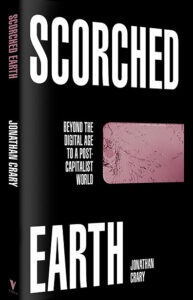
Scorched Earth: Beyond the Digital Age to a Post-Capitalist World, by Jonathan Crary, has a multiple-entendre title — he’s describing what the internet is doing to society, he’s describing what capitalism’s long trajectory is doing to the Earth, and he’s writing in a style that can only be characterized as a scorched-earth approach to the platitudes that dominate our contemporary lives.
In other words, it’s a blistering polemic worthy of the blistering heat waves wracking the Indian subcontinent as I write, and that are baked in to our future by our continuing inability to halt the complex machine of global capitalism.
Crary’s 120-page screed follows in “a tradition of social pamphleteering,” but in a way that has long fallen by the wayside. Rarely do authors address our common predicament with the fine-tuned anger and precise rhetorical scalpel of a skilled surgeon working on the body politic. But Crary, a Columbia University professor, has done it before in his 2013 book-length essay 24/7, where he pulled down the facade masking the insanity of our sped-up world.
In Scorched Earth he’s trying to knock the legs from under our endless narcissistic return to the screen in our hands, and proposes that if he succeeds, our tasks will only be much more daunting than even breaking that obvious addiction.
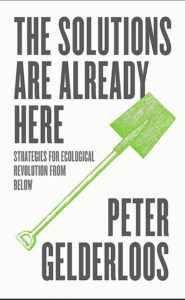
In another new book by Peter Gelderloos (The Solutions Are Already Here: Tactics for Ecological Revolution from Below, Pluto Press: 2022), which parallels Scorched Earth in key ways, he argues “The cause of the global ecological crisis is colonialism. It is no coincidence that the political, economic, and cultural institutions that were developed by the most successful northern European colonizers are the ones that are now global.” (p. 34)
Both Crary and Gelderloos are offering short but comprehensive and totalizing critiques of the world as we know it. Both take on basic categories of our lives such as science and technology, militarism, and our relationship to nature. Where Crary excels is in his directed criticism of our ongoing acquiescence to the internet. For most readers who are almost certainly seeing these words on a computer screen, it may be difficult to digest that the entirety of the internet is the target of his most potent critique:
“… as a constitutive component of twenty-first-century capitalism, the internet’s key functions include the disabling of memory and the absorption of lived temporalities, not ending history but rendering it unreal and incomprehensible… The internet complex is now the comprehensive global apparatus for the dissolution of society.” (pp. 8–9)
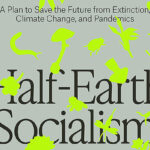
The authors of Half-Earth Socialism are visionaries, utopians, and planners. In a short book they marshal an argument for what they argue is a way out of the double-bind of a seemingly inevitable capitalism bent on ecocide versus a myopic Left that is stuck on either centralized authoritarianism or ineffective, decentralized anarchist cooperatives:
“The goals of Half-Earth socialism are simple enough: to prevent the Sixth Extinction, practise ‘natural geoengineering’ to draw down carbon through rewilded ecosystems rather than SRM [solar radiation management], and create a fully renewable energy system. Realizing each of these aims requires large expanses of land, which is why we will see again and again that utopia is threatened by the Earth-eating livestock industry.” (Pg. 79)
“Half-Earth Socialism” sets out the importance of and necessity to consciously plan our material, economic lives, as opposed to leaving it all to the invisible hand of the market. The authors also argue that we must accept that nature, or global ecology, is the ultimate mystery that we cannot (and should not try to) master, even though we’ve spent two centuries laboring under the hubristic assumption that science will give us the tools and knowledge to do so.
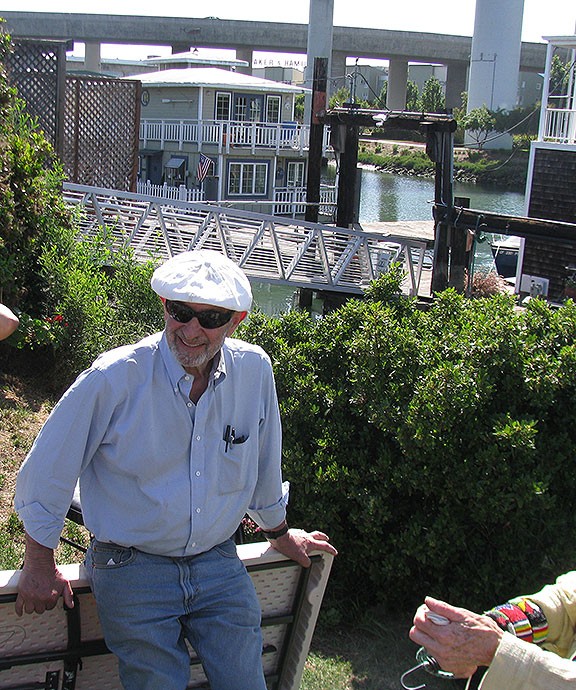 Bob Isaacson at the annual Fourth of July party at Huffaker Park along Mission Creek, 2013. Saturday, May 7, 2022 at the Bayview Boathouse, a memorial for Bob Isaacson.
I am sorry not to be here in person, but as I am still testing positive for Covid, I think it best to stay home.
I met Bob Isaacson around 2010. I had known the amazing book Vanished Waters: A History of San Francisco’s Mission Bay for some years; it was (and is) the main source for understanding the history of the eastern side of San Francisco—Mission Bay, once a body of water, and now a dense and modern neighborhood. The book was produced in 1986 by the Mission Creek Conservancy and written by historian Nancy Olmsted. I was interested in getting more copies and when I made inquiries, Bob responded to let me know the book was out of print.
One thing led to another, and a few months later I was involved with Bob in exploring how we could reproduce the book and publish a 2nd edition. It was made more difficult by the fact that all the original materials for the first edition were lost, so it was going to take a fair amount of sleuthing and research to find the maps and photos from the first book, and of course all the text would have to be re-done as well. This was up my alley, being a book designer and longtime typesetter, as well as a self-taught historian and curator for Shaping San Francisco’s digital archive at foundsf.org.
About a year later, we had a sparkling new edition, with new and improved maps and images, and several new chapters that I wrote, some of which depended on Bob and his ability to wrangle a number of key participants in the multi-year process of building the new Mission Bay, to participate in a series of oral history interviews.
Bob himself was an indispensable character through all the years that Mission Bay went from a derelict industrial and rail yard zone to the dynamic neighborhood it is today. Along with Ginny, Corinne, Toby, Phillip, Ruth, and other Mission Creek Conservancy members Bob’s years-long effort to make Mission Creek an ecological gem has borne fruit. What was once a smelly Shit Creek, is now an ecological wonderland, a birding paradise, and a thriving waterway with rich life on and below the surface. Bob worked tirelessly to reconnect the area to its own history, both socially and ecologically. And he did it with great modesty, kindness, and good humor.
Few San Franciscans have left as important a legacy as Bob Isaacson, and though he has gone largely unheralded during his life for his steady presence and dedicated vision, I’m here to say that he deserves to be remembered in the pantheon of our most revered, and that he will not be forgotten. Thank you Bob!
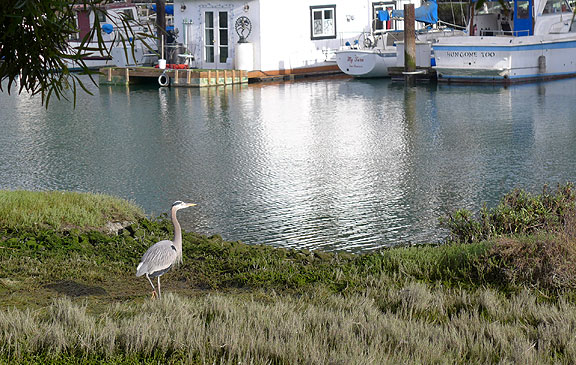 A heron stands in the pickleweed overlooking Mission Creek, a vision inconceivable without the stalwart efforts of Bob Isaacson.
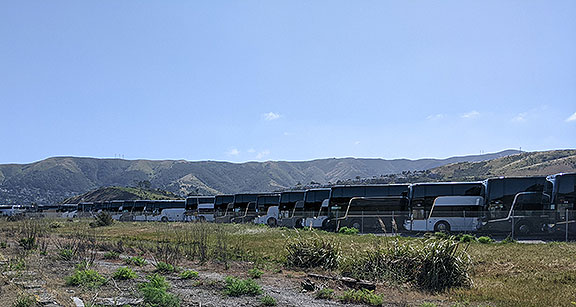 A luxury tech bus graveyard near the SF dump on Tunnel Road! (probably they are just parked there when not in use) Once again I’ve left my blog languishing. I have a better excuse than usual. I’m working on a new novel! Have about 75,000 words written so far, and probably as many more to come. I hope to wrap up a first draft sometime in summer, and then there will be the rigorous purging and rewriting… we’ll see how it all goes. But the good news is that so far I’m having fun. I got past the beginning slog, and now the book is just coming to me every time I sit down to write. I always have a chapter or two in mind and just go into the moment and let the story unfold. It’s a blast when it flows like that.
That said, I still carry on reading all sorts of fascinating books, some of which should help my character and scene development in the novel (sneak preview: it’s set starting in 2023, but mostly later in the mid-2020s, finally ending in 2050, working title is “When Shells Crumble”—it was supposed to the prequel to my 2004 novel After the Deluge but it has shifted too much and I wouldn’t characterize it that way anymore… though there are a few connective tissues).
And I also can report that I am continuing to be cancer-free. The melanoma has not reappeared and I just had my every-three year colonoscopy and it didn’t turn up anything worrisome either, I’m happy to report. I have had a weird shoulder/upper arm injury that has persisted for several months now. I just had a great therapeutic massage today and am optimistic that a new approach to my daily exercise and posture may help me recover sooner than later. I have had to give up weekly frisbee throwing (that’s probably how I hurt myself in the first place) but continue to enjoy petanque, and can’t help but love having my granddaughters leap into my (aching) arms! I’m on Medicare now, which is a much worse deal than the CoveredCA deal I had until I turned 65 a month ago. But it’s better than nuttin’.
The Russian attack on Ukraine is dominating the headlines and pushing out of sight the dire humanitarian crisis in Afghanistan imposed by the US impounding billions of their national assets. Rendered invisible also are the ongoing catastrophes in Yemen, Gaza, Sudan, Somalia, etc., all fueled by US arms sales and political support for barbaric regimes. Meanwhile climate refugees are fleeing violence and collapsing ecologies in Central America, northern Africa, and other regions, all of which is driving the rightwing xenophobia that continues to gain political momentum. It’s a bad time on ol’ Planet Earth!
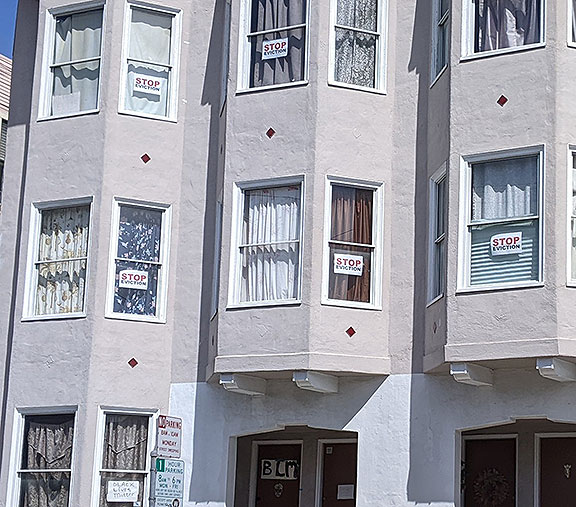 This building on 25th Street a few blocks from my house is organized against being evicted by way of California’s evil Ellis Act. Price Wars is a new book by Rupert Russell, an enterprising journalist who decided to visit many of the most problematic spots on the globe to see what was driving the crises. He visits eastern Ukraine, exactly where the new Russian attack is unfolding as I write. He goes to Kenya and Guatemala too. But his main point is that prices, that seemingly neutral outcome of market transactions based on supply and demand, are anything but neutral or “natural” (as the neoliberals tend to argue). He details the role of speculation and derivatives in driving all sorts of price dislocations (in energy, food, and other basics of modern life) which completely separate prices from their signaling function, and instead become a means of deceiving large numbers of people while a very small number of people are pocketing vast social wealth.
It is the collectively shared perception of reality, rather than reality itself, that drives prices.
p. 171
Their irrationality serves a rational interest. It is how those who sit atop the market pyramid are able to transfer wealth from others to themselves. It is precisely prices’ inefficiencies and inaccuracies, their ability to manipulate, hide, amplify and narrate that makes them engines of enrichment as well as engines of chaos… The market mythologisers have deployed the same tactic. As I had seen again and again, migrants had played a pivotal role in keeping the would-be reformers at bay. The Feed, filled with the “rapist hordes” and “invading caravans,” served up ready-made scapegoats, deflecting attention from the inscrutable financial alchemy to the photo-friendly “barbarians at the gate.”
p. 239
In my previous post I discussed in depth various aspects of our militaristic society and the omnicidal impulse shaping the colonial logic that has spread across the planet for the past five centuries. I read Born in Blackness: Africa, Africans, and the Making of the Modern World, 1471 to the Second World War by Howard French (Liveright Publishing Co., W.W. Norton & Co., 2021). French is a longtime New York Times reporter, which doesn’t necessarily establish much credibility in my mind, but this is a wonderful book. It helpfully backs up the “beginning” of our timeline to decades before Columbus’s 1492 voyages to the Caribbean. He recounts the tale of a prominent king from Mali who traveled in the early 1300s to Mecca by way of Egypt and gave away several hundred tons of gold along the way to prove his power and wealth. Stories of this gold-laden monarch and his kingdom in Africa made it to Europe and sparked early Portuguese exploration voyages along the West African coast decades later in the early 1400s. Our common histories have portrayed Portuguese exploration as a brief sojourn along West Africa before one of their explorers finally made it around the southern tip of Africa and “discovered” the Indian Ocean, eventually establishing trading posts in East Africa, India, Malaysia, Indonesia and China (Macau). French corrects this deeply deceptive account. Actually it was a slow process, taking many decades, before that journey around the Cape of Good Hope and into the Indian Ocean. During those decades Portuguese traders gained preferential access to gold trading first, and then trading in black humans in West Africa and eventually further south in what is later Angola. With this early trade in gold and slaves, the Portuguese state became one of the wealthiest in that period, eventually taking over the island of Sâo Tomé where they pioneered the sugar plantation using slave labor (this followed the heavy exploitation of the Atlantic island of Madeira, and then later the Canary Islands). The integrated sugar plantation was then transplanted to Portuguese colonies in northeastern Brazil before finding its full barbaric development in the Caribbean under Dutch, British, and French control more than a century later.
Continue reading Organ Recital
|
|


















